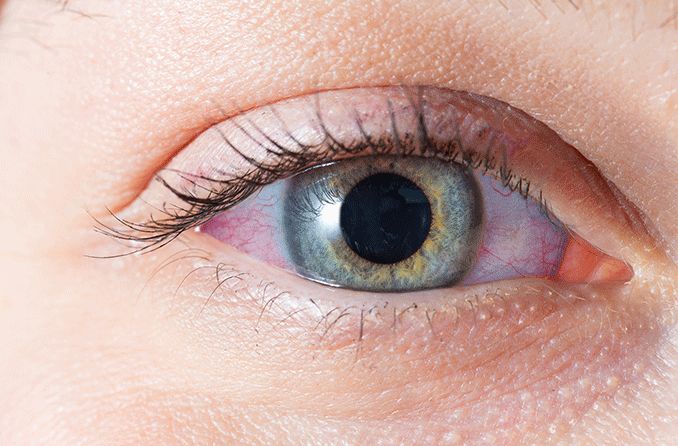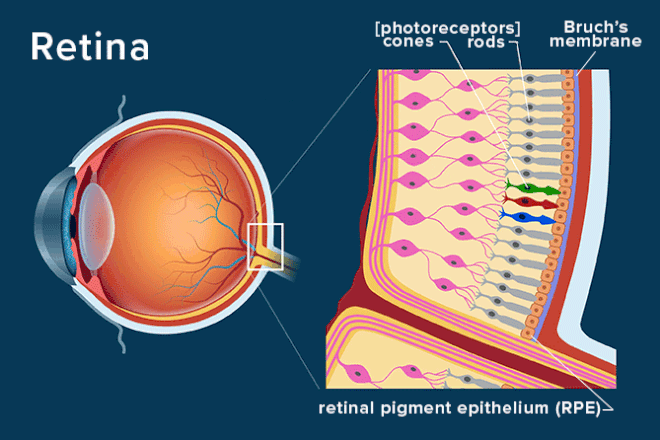Pseudoxanthoma elasticum (PXE)

What is pseudoxanthoma elasticum?
Pseudoxanthoma elasticum (PXE, pronounced “pixie”) is a rare, inherited disease that causes a calcium or mineral buildup in different tissues of the body. PXE can potentially affect the eyes, skin, blood vessels and, less frequently, the digestive system. It is a progressive condition.
The condition commonly affects the body’s elastic tissues — including the skin in the armpits, neck and knees. In many cases, skin can appear waxy and yellow, and it can have loose folds with a cobblestone-like texture.
PXE also causes eye problems — particularly in the retina. A clinical diagnosis is made through a biopsy of a skin lesion and/or an eye exam. Fewer than 50,000 people in the United States have PXE, according to scientific estimates. Symptoms may appear anytime in life.
How pseudoxanthoma elasticum affects the eyes
When PXE affects the eyes, it can cause cracks or breaks in an elastic tissue called Bruch’s membrane. Bruch’s membrane is a thin structure located between the retina (the light sensing tissue in the back of the eye) and the choroid (the eye’s blood vessel layer).
The breaks in Bruch’s membrane can lead to jagged lines on the retina called angioid streaks. Angioid streaks can be detected with a dilated eye examination. In lightly pigmented individuals, they appear red. In more darkly pigmented individuals, they have a brownish hue.

Eye anatomy illustration of the Bruch's membrane in the back of the retina
Angioid streaks alone do not cause vision issues. The most common complication of angioid streaks is choroidal neovascularization (CNV). CNV is the development of new blood vessels that grow through the “cracks” formed by angioid streaks.
These new blood vessels can leak, causing scars in the macula, which can lead to vision loss. Bleeding in the eye can lead to central vision loss. Even when central vision loss occurs, most PXE patients retain their peripheral vision.
Other ways the eyes may be affected by PXE include:
Peau d’orange – When the retina looks like an orange peel due to mottling of retinal pigment
Blue sclera – When the white portion of the eye (called the sclera) has a blue or purplish tint due to a transparency of the collagen fibers in the sclera
The majority of PXE patients will experience eye symptoms at some point. Onset for angioid streaks is typically between 15 and 25 years, while peau d’orange can occur earlier in life. These conditions typically occur in both eyes.
SEE RELATED: When to visit a retina specialist
PXE symptoms
Pseudoxanthoma elasticum affects many parts of the body, and it can cause a variety of symptoms.
Some of the most common signs and symptoms of PXE include:
Skin changes and abnormalities, including yellowish bumps
Tight and/or very wrinkled skin
Rash
Bruising easily
Abnormalities in the cerebral vasculature (blood vessels in the brain)
Malformations within the cardiovascular system
Narrowed arteries
Bleeding in the stomach
Weakness in legs
Reduced vision
Angioid streaks on the retina
Causes of pseudoxanthoma elasticum
PXE is an inherited disease. It is caused by a mutation in the ABCC6 gene. Experts believe that this gene is responsible for keeping the elasticity within the body’s tissues stable and healthy.
If the ABCC6 gene is mutated, it can affect the way it functions. And if it doesn’t function properly, it can impact the state of elasticity in the body, leading to conditions such as PXE.
SEE RELATED: Learn how DNA health testing can detect eye diseases
Treatment and management of pseudoxanthoma elasticum
Because PXE affects the area that produces central vision, a patient can monitor changes in vision with a tool called an Amsler grid.
An Amsler grid is a square grid with a dot in the center. It is held about sixteen inches in front of the patient. The patient focuses on the center dot with one eye (covering the other). If the person notices dark spots, blurriness, wavy lines or other irregularities in the grid, there may be a problem with their central vision.
Vision aids, such as magnifying and telescope glasses, are available for those with low vision. PXE patients are also encouraged to stay away from activities that could cause eye trauma, such as sports or heavy physical activity. The same goes for activities that may raise pressure in the eyes (such as weight lifting). Trauma of any sort can increase the chances of retinal bleeding and cause further complications.
PXE patients should also avoid non-steroidal anti-inflammatory drugs (NSAIDs), such as ibuprofen and aspirin. NSAIDs can raise the risk of bleeding in the eyes and GI tract.
Those who experience skin changes due to PXE may receive cosmetic surgery for a more favorable appearance.
Regardless of the way pseudoxanthoma elasticum affects your body, it’s very important to monitor any changes and report them to your healthcare provider as soon as possible.
When to see a doctor
If you experience any symptoms associated with PXE, contact your primary care physician immediately. Since PXE affects so many parts of the body, it may be necessary to see one or more specialists to assess your personal condition. This can include an ophthalmologist or other eye care provider.
Changes in vision or eye problems are important to address as soon as possible, whether they are related to PXE or not. Don’t hesitate to contact your eye doctor if you experience any sudden changes in vision or eye pain. The sooner you can get an exam and/or treatment, the better the outlook will be for your vision.
Pseudoxanthoma elasticum (PXE). Macular Society. August 2021.
Pseudoxanthoma elasticum. Genetic and Rare Diseases Information Center. February 2023.
Angioid streaks. EyeWiki. American Academy of Ophthalmology. September 2022.
Pseudoxanthoma elasticum. EyeWiki. American Academy of Ophthalmology. January 2023.
Pseudoxanthoma elasticum. National Organization for Rare Disorders. June 2018.
About PXE. PXE International. Accessed February 2023.
Have AMD? Save your sight with an Amsler grid. American Academy of Ophthalmology. May 2020.
Page published on Wednesday, March 1, 2023
Page updated on Tuesday, March 7, 2023
Medically reviewed on Wednesday, January 18, 2023







